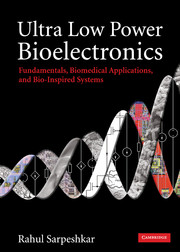Book contents
- Frontmatter
- Contents
- Acknowledgements
- Section I Foundations
- 1 The big picture
- 2 Feedback systems: fundamentals, benefits, and root-locus analysis
- 3 MOS device physics: general treatment
- 4 MOS device physics: practical treatment
- 5 MOS device physics: small-signal operation
- 6 Deep submicron effects in MOS transistors
- 7 Noise in devices
- 8 Noise in electrical and non-electrical circuits
- 9 Feedback systems
- 10 Return-ratio analysis
- Section II Low-power analog and biomedical circuits
- Section III Low-power RF and energy-harvesting circuits for biomedical systems
- Section IV Biomedical electronic systems
- Section V Principles for ultra-low-power analog and digital design
- Section VI Bio-inspired systems
- Section VII Energy sources
- Bibliography
- Index
- Epilogue
- References
8 - Noise in electrical and non-electrical circuits
from Section I - Foundations
Published online by Cambridge University Press: 02 December 2010
- Frontmatter
- Contents
- Acknowledgements
- Section I Foundations
- 1 The big picture
- 2 Feedback systems: fundamentals, benefits, and root-locus analysis
- 3 MOS device physics: general treatment
- 4 MOS device physics: practical treatment
- 5 MOS device physics: small-signal operation
- 6 Deep submicron effects in MOS transistors
- 7 Noise in devices
- 8 Noise in electrical and non-electrical circuits
- 9 Feedback systems
- 10 Return-ratio analysis
- Section II Low-power analog and biomedical circuits
- Section III Low-power RF and energy-harvesting circuits for biomedical systems
- Section IV Biomedical electronic systems
- Section V Principles for ultra-low-power analog and digital design
- Section VI Bio-inspired systems
- Section VII Energy sources
- Bibliography
- Index
- Epilogue
- References
Summary
When we tug on a single thing in nature, we find it attached to everything else.
John MuirDevices that dissipate energy, such as resistors and transistors, always generate noise. This noise can be modeled by the inclusion of current-noise generators in the small-signal models of these devices. When several such devices interact together in a circuit, the noise from each of these generators contributes to the total current or total voltage noise of a particular signal in a circuit. In this chapter, we will understand how to compute the total noise in a circuit signal due to noise contributions from several devices in it. We shall begin by discussing simple examples of an RC circuit and of a subthreshold photoreceptor circuit. We shall see that the noise of both of these circuits behaves in a similar way. We shall discuss the equipartition theorem, an important theorem from statistical mechanics, which sheds insight into the similar noise behavior of circuits in all physical systems. We shall then outline a general procedure for computing noise in circuits and apply it to the example of a simple transconductance amplifier and its use in a lowpass filter circuit. We will then be armed with the tools needed to understand and predict the noise of complicated circuits, and to design ultra-low-noise circuits.
We shall conclude by presenting an example of an ultra-low-noise micro-electro-mechanical system (MEMS), a capacitance-sensing system capable of sensing a 0.125 parts-per-million (ppm) change in a small MEMS capacitance (23-bit precision in sensing).
Information
- Type
- Chapter
- Information
- Ultra Low Power BioelectronicsFundamentals, Biomedical Applications, and Bio-Inspired Systems, pp. 184 - 211Publisher: Cambridge University PressPrint publication year: 2010
